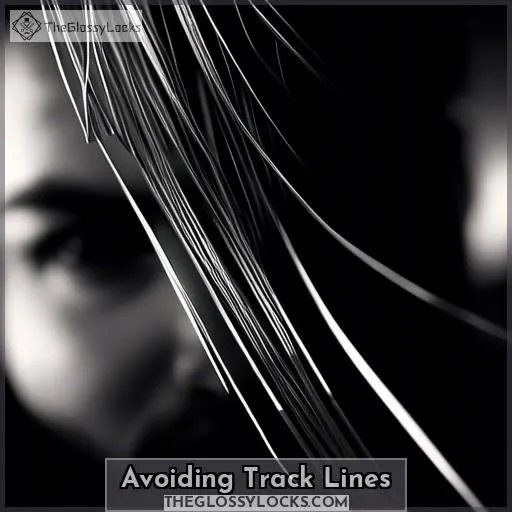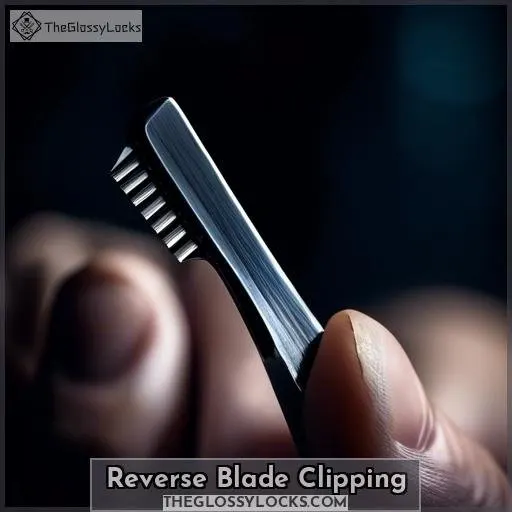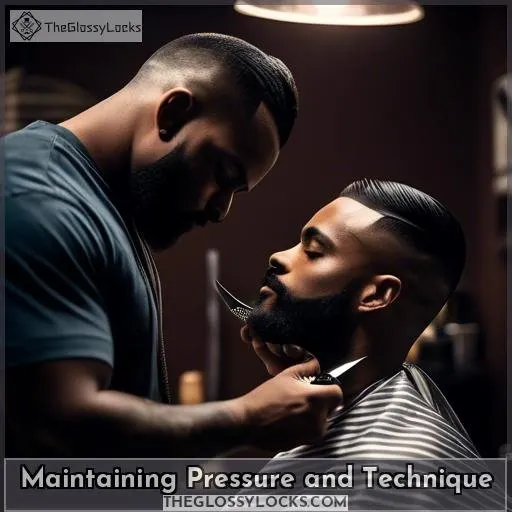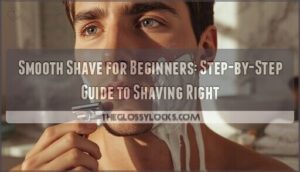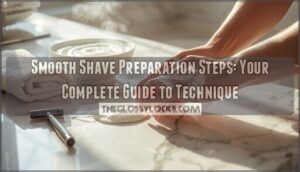This site is supported by our readers. We may earn a commission, at no cost to you, if you purchase through links.
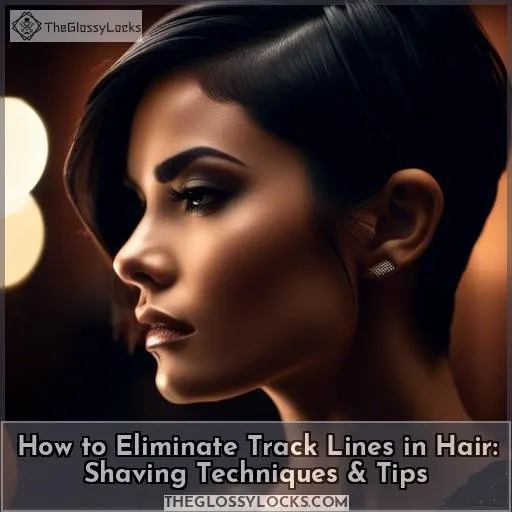
- Sharp Blades: Use sharp blades for your grooming tools. The sharper the blade, the smoother the cut.
- Powerful Clippers: Invest in a powerful set of clippers that can handle thick and dense coats. They don’t necessarily need to be large and clunky, but they should have enough power, speed, and torque to glide effortlessly through the coat.
- Consistent Speed: Maintain a consistent speed when clipping through the coat. This helps to reduce lines.
- Card Thick Coats: Before and after clipping, card thick and dense coats to remove as much dead undercoat as possible. This helps to prevent clogged clipper blades and reduces lines.
- Follow the Lay of the Coat: Always follow the natural lay of the coat either by clipping with the grain or against the coat growth. Cross coat cutting typically creates track lines, so focus on working with the natural lay of the coat.
- Reverse Blade Clipping: When the coat growth pattern is distinctive, reverse clipping can be beneficial to remove or eliminate clipper tracks. Instead of working with the coat growth, work directly against it. Reverse clipping cuts the coat closer than working with the grain.
- Maintain a Consistent Tip: Keep a consistent degree of tip on the blade as you clip. Every clipper blade works most efficiently when the heel of the blade is tipped up slightly.
- Consistent Pressure: Keep consistent pressure against the skin as you clip. The weight of the clipper is usually the correct pressure to apply.
- Fine Detailed Thinners: Use fine detailed thinners to work as erasers on stubborn lines. When all else fails, you can buffer clipper lines with thinning shears, knocking off just the high points of the tracks.
- Every Coat Type is Different: Each coat type has its own characteristics, and learning how to minimize tracking takes time and practice.
- Mastering a Smooth Clipper Cut: Mastering a smooth clipper cut in the least amount of time takes focus and attention to details.
- Coaching from a Seasoned Professional: If you’re struggling, consider seeking help from a seasoned professional, such as a groomer or a coach.
By following these tips and techniques, you can significantly reduce or eliminate track lines in hair.
Table Of Contents
- Key Takeaways
- How to Shave Lines in Hair
- Avoiding Track Lines
- Reverse Blade Clipping
- Maintaining Pressure and Technique
- Community Input
- Frequently Asked Questions (FAQs)
- How can I avoid shaving lines in my hair?
- What is the best technique for reverse blade clipping?
- How can I maintain consistent pressure and technique while shaving?
- Where can I find resources to improve my hair shaving skills?
- How can I handle cultural insensitivity and racial disparities related to hair shaving?
- What are some alternatives to shaving for body hair removal?
- How can I use a beard trimmer for body hair shaving?
- What are the benefits of using a beard trimmer for body hair removal?
- How do trimmers and razors compare for hair removal?
- What is the proper maintenance for trimmers?
- Conclusion
Key Takeaways
- Use sharp blades and powerful clippers to ensure smooth cuts and handle thick coats effectively.
- Maintain a consistent clipping speed and follow the natural lay of the coat to prevent track lines.
- For reverse blade clipping, work against the coat growth and adjust the blade length appropriately for a closer cut.
- Engage with online communities and seek guidance from professionals to improve technique and learn new tips.
How to Shave Lines in Hair
To shave lines in hair, you can use a shavette or a safety razor with a creamy lather from shaving cream or shaving soap. This provides a more efficient shaving experience. If you want to even the edges and not shave any large surfaces, you can use a pre-shave oil or pre-shave gel instead of lather.
Then, you can go straight to the area you want to shave. A shavette is often the most effective tool for flaunting the edges with finesse, as it has the same blade as a safety razor but offers unbeatable shaving performance.
If you’re looking to create clean lines in a beard, it is recommended to shave as usual on the larger areas and then use a shavette and oil or gel for the clean lines.
Avoiding Track Lines
To avoid track lines in your hair, use sharp blades and powerful clippers, clip at a consistent speed, card thick coats before and after clipping, and follow the lay of the coat.
Use Sharp Blades
To avoid track lines in hair, use sharp blades. Replace blades regularly, maintain blade sharpness, and ensure blade quality. Sterilize clipper blades for hygiene. A sharp clipper cut requires consistent pressure and technique.
Use Powerful Clippers
To eliminate track lines in hair, you need powerful clippers. Look for clippers with a high blade speed, as this ensures a smooth cut.
Regular clipper maintenance is crucial, including blade tension adjustments, clipper oiling, and replacing clipper blade teeth.
Consider the clipper’s weight and wrist comfort when choosing a clipper, as this can impact your technique.
Fine clipper thinners can help erase stubborn lines. Remember, every coat type is different, so mastering the art of clipper cutting takes practice.
Clip at a Consistent Speed
Clipping at a consistent speed is crucial for avoiding track lines. Adjust your clipper speed to maintain a steady pace, and be mindful of blade speed. Keep your clipper work smooth and even, and always follow the lay of the coat. Practice these techniques to master the art of grooming and eliminate track lines.
Card Thick Coats Before and After Clipping
Carding thick coats before and after clipping is a crucial technique to avoid track lines. This process involves using a carding tool to remove excess hair and straighten the coat, ensuring a smoother clip.
Post-clipping carding helps maintain the desired length and texture. By following these carding techniques, you can effectively eliminate track lines and achieve a more polished, professional look.
Follow the Lay of the Coat
To follow the lay of the coat and avoid track lines, consider these tips:
- Clip in the direction of coat growth
- Adjust clipper pressure for different coat thicknesses
- Use a supple wrist for smooth strokes
- Fine-tune your clipper technique with practice
By understanding and adhering to these clipper tricks, you can master the art of shaving lines in hair, enhancing your grooming skills and boosting your confidence.
Reverse Blade Clipping
Reverse blade clipping can eliminate track lines in hair. This technique involves working against the coat growth and cutting closer than with the grain.
To perform reverse blade clipping, you need to bump up the blade two lengths longer than usual and maintain a consistent tip on the blade. This method is effective for eliminating tracks and can be used on various coat types, but it requires practice to master.
Reverse Blade Clipping Can Eliminate Tracks
Reverse blade clipping is a technique that can help you eliminate track lines in your hair.
To do this, you’ll need to work against the coat’s growth, which allows you to achieve a closer cut than with the grain.
To maintain a consistent tip on the blade, bump it up two lengths longer than usual.
For more guidance, consider resources like coaching from a seasoned professional or attending local clinics or workshops.
Work Against the Coat Growth
To work against coat growth and eliminate track lines, consider reverse blade clipping. This technique involves clipping against the direction of hair growth, which can cut closer to the skin and create a smoother finish.
- Pressure: Maintain consistent pressure against the skin to ensure an even cut.
- Consistency: Clip at a consistent speed to avoid unevenness.
- Coat Growth: Adjust the clipper angle to navigate the complexities of coat growth.
- Blade Sharpness: Use sharp blades for a cleaner, more precise cut.
- Clipper Angle: Adjust the clipper angle to account for the direction of coat growth.
- Consistency: Keep a supple wrist to maintain control and precision.
By incorporating these tips, you’ll be able to master the art of reverse blade clipping and achieve a smooth, track-free finish.
Reverse Clipping Cuts Closer Than With the Grain
Reverse clipping is a technique that can help you achieve closer cuts than with the grain.
By working against the coat growth, you can eliminate track lines and achieve a more polished look.
To do this, you’ll need to bump up the blade two lengths longer and maintain a consistent tip on the blade.
This method requires a bit of practice and attention to detail, but the results are worth it.
Bump Up the Blade Two Lengths Longer
To achieve a closer cut when reverse blade clipping, you should bump up the blade two lengths longer. This adjustment allows the blades to work against the coat growth, providing a more precise shave. Maintaining a consistent tip on the blade is also crucial for a smooth finish. Practice makes perfect, so mastering this technique takes time and patience.
Maintain a Consistent Tip on the Blade
To maintain a consistent tip on your blade while reverse blade clipping, you need to ensure that the blade is sharp and angled correctly.
Keep in mind that the blade length and angle can vary depending on the type of coat you’re working with. Regular blade maintenance, such as cleaning and replacing the blade when necessary, is crucial for maintaining a consistent tip.
Maintaining Pressure and Technique
To maintain pressure and technique while shaving lines in hair, follow these tips:
- Keep consistent pressure against the skin: Apply even pressure to ensure a smooth cut without irritation or nicks.
- Keep a supple wrist: A flexible wrist allows for better control and precision when shaving.
- Use fine detailed thinners: These tools can help erase stubborn lines and provide a more refined finish.
- Every coat type is different: Adapt your technique to suit the specific needs of the coat you’re working on.
- Mastering a smooth clipper cut takes practice: Improve your skills with time and experience.
For further improvement, consider resources such as:
- Notes from the Grooming Table book
- Streaming video platform
- Local clinics or workshops
- Coaching from a seasoned professional
Remember to share your tips with the community on Facebook pages to help others eliminate tracking in their hair.
Keep Consistent Pressure Against the Skin
Keeping consistent pressure against the skin while shaving is crucial for eliminating track lines.
- Pressure Techniques: Apply gentle pressure to the skin, ensuring the clipper glides smoothly without pulling or tugging.
- Consistent Pressure: Maintain a steady pressure throughout the clipping process to prevent track lines from forming.
- Wrist Flexibility: Keep your wrist supple to ensure a smooth, even clip.
These techniques, combined with sharp blades and powerful clippers, can help you achieve a clean, track-line-free shave. Remember, every coat type is different, so practice and patience are key to mastering the smooth clipper cut.
Keep a Supple Wrist
Keeping a supple wrist is crucial when shaving lines in hair. This involves hand flexibility and ergonomic clipper technique. Imagine your wrist as a dancer’s, gracefully navigating the complexities of the hair’s realm.
It’s not merely about grip strength; it’s about understanding the ever-evolving needs of each coat type.
Fine Detailed Thinners Can Erase Stubborn Lines
After mastering the art of keeping a supple wrist, it’s time to tackle those stubborn lines that just won’t budge.
Think of fine detailed thinners as your magic eraser tool. These thinning techniques are your secret weapon against the most persistent tracks, adapting effortlessly to various coat types.
It’s like having a precision eraser in your grooming toolkit, making every stroke count.
Every Coat Type is Different
When it comes to shaving different coat types, grooming differences and texture variations play a crucial role.
Understanding breed-specific techniques and skin sensitivity is key to mastering a smooth clipper cut.
Each coat type requires tailored care to eliminate track lines effectively.
Embrace the challenge of diverse textures and groom with finesse.
Mastering a Smooth Clipper Cut Takes Practice
Mastering a smooth clipper cut demands practice, consistency, and technique. The key lies in maintaining pressure against the skin with a supple wrist. Experience is your best teacher; every coat type is unique. Remember, it’s a skill that grows with time and effort.
Local Clinics or Workshops
To further enhance your clipper cutting skills, consider attending local workshops for professional development and skill building.
These workshops offer valuable opportunities for continuing education and certification, allowing you to refine your techniques and master the art of smooth clipper cuts.
Engaging with seasoned professionals in these settings can provide insights and tips that are essential for eliminating track lines in hair effectively.
Coaching From a Seasoned Professional
Seeking guidance from a seasoned pro can be your game-changer in mastering the art of shaving. They’ll show you the ropes, from choosing the right clipper size and blade type to perfecting your wrist position.
Whether tackling a thick coat or finessing your technique, their wisdom turns you into a shaving maestro, making every stroke count.
Community Input
In the realm of hair shaving, community input is a vital source of knowledge and support.
- Cultural exchange: Engage in discussions about hair discrimination and the importance of cultural sensitivity. Share your experiences and learn from others.
- Social media support: Join Facebook groups and other online communities dedicated to hair shaving techniques. Share tips and tricks, and learn from others’ experiences.
- Peer learning: Participate in local clinics or workshops to learn from professionals and fellow enthusiasts. This is a great opportunity to master the art of hair shaving.
- Hair discrimination: Raise awareness about the issue of hair discrimination and its impact on black students. Use your voice to advocate for change and promote understanding and acceptance.
Frequently Asked Questions (FAQs)
How can I avoid shaving lines in my hair?
To avoid shaving lines in your hair, ensure you shave with the grain, use sharp blades, maintain consistent pressure, and go slow. Take your time, follow proper techniques, and consider professional advice for a flawless shave.
What is the best technique for reverse blade clipping?
Reverse blade clipping is like sculpting with a precision knife, cutting against the grain to eliminate track lines. It’s an art form that requires skill and finesse, creating a seamless finish for a flawless groom.
How can I maintain consistent pressure and technique while shaving?
To maintain consistent pressure and technique while shaving, ensure a supple wrist, apply gentle pressure against the skin, and practice with fine detailed thinners for stubborn lines.
Where can I find resources to improve my hair shaving skills?
Like a chef sharpening knives, honing your hair shaving skills requires the right resources. Dive into Notes from the Grooming Table, stream instructional videos, or attend local workshops.
How can I handle cultural insensitivity and racial disparities related to hair shaving?
To handle cultural insensitivity and racial disparities related to hair shaving, it’s crucial to approach the situation with empathy and understanding.
Educate Yourself: Learn about the history of hair discrimination and its impact on Black communities. This will help you understand the complexities and sensitivities surrounding hair shaving in different cultures.
Promote Inclusivity: Encourage the acceptance of diverse hairstyles and avoid imposing strict grooming policies that may target certain hair types or styles.
Challenge Discriminatory Practices: If you witness or experience discrimination based on hair styles, speak up and advocate for change. This could involve raising awareness, contacting organizations like the ACLU, or supporting legislation like the CROWN Act that aims to protect against hair discrimination.
Celebrate Individuality: Respect and appreciate the unique aspects of each person’s hair and encourage them to express their identity through their hairstyle.
Promote Cultural Humility: As a professional, practice cultural humility by acknowledging your own lack of knowledge on hair care practices from different cultures and religions, and actively seek to learn more.
What are some alternatives to shaving for body hair removal?
If you’re seeking alternatives to shaving for body hair removal, consider options like waxing, sugaring, depilatory tools, or creams. A men’s facial hair trimmer can also be effective, leaving a small amount of stubble and minimizing skin irritation.
Invest in a quality beard trimmer designed for body grooming, and remember to clean and maintain it properly.
How can I use a beard trimmer for body hair shaving?
Harness the power of a beard trimmer to master body hair grooming. Exfoliate, dry, and trim for a tailored look that minimizes irritation, embodying the art of precision and the freedom of self-expression.
What are the benefits of using a beard trimmer for body hair removal?
Using a beard trimmer for body hair removal offers several benefits. It’s less sharp than razors, reducing irritation, and is gentle on sensitive skin. Customization options with comb extensions cater to different bush preferences, making it convenient for last-minute hair removal.
Trimmers minimize skin irritation and leave a small amount of stubble, which can be beneficial for some individuals.
How do trimmers and razors compare for hair removal?
Trimmers and razors both have their advantages and disadvantages when it comes to hair removal. Trimmers leave a small amount of stubble, minimizing skin irritation, and offer customization options. Razors provide a closer shave but can cause skin irritation. It’s essential to consider your preferences and skin type when choosing between the two.
What is the proper maintenance for trimmers?
To properly maintain your trimmer, clean it regularly with the included brush, sanitize using organic spray, replace heads as needed, store in a dry place, and follow manufacturer’s instructions for maintenance.
Conclusion
To achieve the smoothest clipper cut possible, it’s crucial to understand the unique needs of each coat type and master the techniques outlined in this article.
By using sharp blades, powerful clippers, maintaining a consistent speed, and following the lay of the coat, you can significantly reduce track lines.
For stubborn lines, fine detailed thinners can act as erasers.
Remember that every coat type is different, and mastering a smooth clipper cut takes practice.

